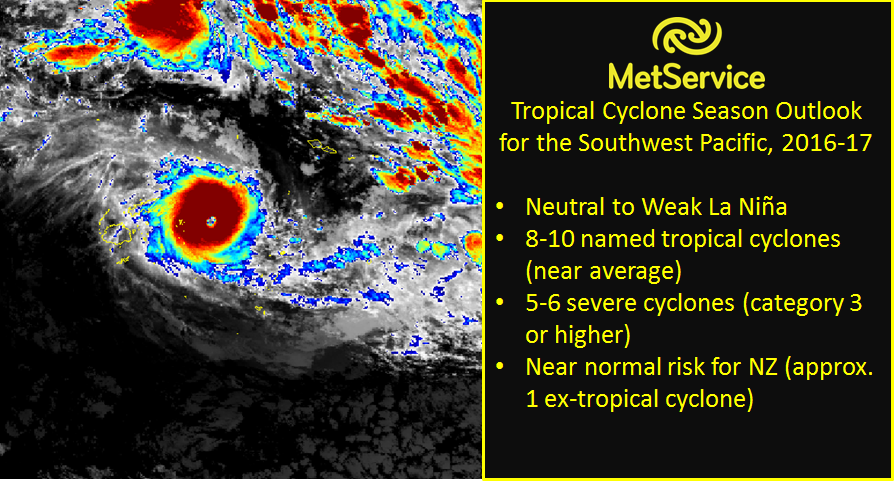Tropical Cyclone activity expected to be average this season
MetService News Release
14
October 2016
Tropical Cyclone activity
expected to be average this season
The Southwest Pacific
tropical cyclone season formally starts on the 1st of
November, with an average number of named cyclones expected
in the upcoming 2016/2017 season under the influence of
neutral to weak La Niña conditions.
Every year MetService works alongside NIWA and national meteorological services from other Pacific nations to produce a Tropical Cyclone Outlook for the upcoming season. The outlook for the 2016/2017 season indicates 8 to 10 named cyclones are expected in the Southwest Pacific, with 5 to 6 of those expected to be severe (Category 3 or higher). The average number of named tropical cyclones in the Southwest Pacific (including the Coral Sea) is about 10 per season, based on a 30 year average.
This year, with the El Nino Southern Oscillation (ENSO) cycle tending to weak La Nina conditions, tropical cyclone activity is expected to be near normal for most Pacific Island nations, but elevated activity is expected in the west of the region in and near the Coral Sea. For New Zealand, which is affected by about one ex-tropical cyclone on average per season, the risk is also expected to be near normal.
Around the globe, the role of monitoring and warning for tropical cyclones is performed by a WMO designated Regional Specialized Meteorological Centre (RSMC) or a Tropical Cyclone Warning Centre (TCWC), depending on the location of the cyclone. TCWC Wellington, based at MetService, has warning responsibility for the area that extends from 160E to 120W between 25S and 40S. Although it is very rare for a tropical cyclone to form in the TCWC Wellington area of responsibility, intense tropical cyclones do arrive from the neighbouring Brisbane or Nadi areas and they often retain their named cyclone status until near 30S. Sometimes an ex-tropical cyclone will approach New Zealand and Severe Weather Watches and Warnings need to be issued. Even if land areas are not affected, warnings are still issued for vessels over the open sea.

Infographic highlighting key messages from 2016-17 Tropical Cyclone Season Outlook. Image courtesy of JMA.
Although the tropical cyclone season typically runs from the 1st November until the end of April, cyclone development doesn’t always follow the calendar and cyclones can form outside the season. You can keep up to date with current and expected tropical cyclone activity on the MetService website at; http://info.metraweather.com/e/60812/ings-tropical-cyclone-activity/bjzr8r/433171074where a TC Potential Bulletin will be issued daily from 1st November, or earlier if necessary.


 Plumbers Gasfitters and Drainlayers Board: Plumbers, Gasfitters And Drainlayers Board Drops ‘Journeyman’ And ‘Tradesman’ Names
Plumbers Gasfitters and Drainlayers Board: Plumbers, Gasfitters And Drainlayers Board Drops ‘Journeyman’ And ‘Tradesman’ Names ERANZ: Electricity Saving Coaching Service To Launch In Wairoa
ERANZ: Electricity Saving Coaching Service To Launch In Wairoa SolarZero Affected Staff: SolarZero Staff Are Demanding Answers After The Company Went Into Liquidation
SolarZero Affected Staff: SolarZero Staff Are Demanding Answers After The Company Went Into Liquidation Tātau Tātau O Te Wairoa: Guidance To Save Local Newspapers Amid NZME Closures
Tātau Tātau O Te Wairoa: Guidance To Save Local Newspapers Amid NZME Closures Commerce Commission: Systemic Breaches Of Consumer Law Lead To $1.5million Fine For Kiwibank
Commerce Commission: Systemic Breaches Of Consumer Law Lead To $1.5million Fine For Kiwibank SolarZero: SolarZero Limited (in Liquidation) - Important Business Update
SolarZero: SolarZero Limited (in Liquidation) - Important Business Update



